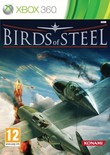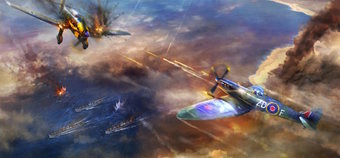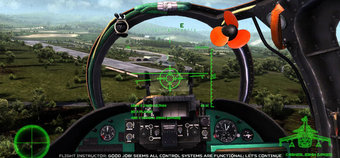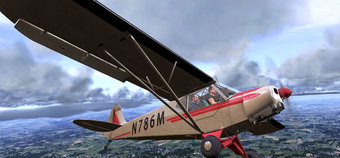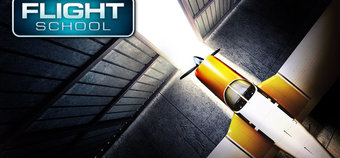It's been a while since a game's got me quite as excited as Birds of Steel. When I was growing up, I practically lived and breathed a diet of flight sims on the old Amiga 500. They were almost all I ever played. The Battle of Britain, Operation Overlord, F-15 Strike Eagle, Gunship, B-17 Flying Fortress - the list went on and on and on. At around the same time as the PC took over from the Amiga as the go-to machine for games, however, a funny thing happened - flight sims seemed to all but disappear. Where once you couldn't move for flight sims, many even based solely around an individual plane, suddenly, flying games were few and far between. Promising to hark back to the days of old, with its dulcet tones assuring us of a game offering historical accuracy, dozens of accurately modelled planes for us to jump into the cockpit of, and an experience that's about as real as flying itself (but yet is scalable enough to cater to flying novices), as well as coming hot off the heels of their last (stunning) flight sim, IL-2 Sturmovik, we were practically exploding with anticipation as we were waiting for Birds of Steel to drop through our letterbox. And then it did.
Birds of Steel is a flight sim set in the Pacific Theatre of World War 2. For those not trained in military terminology, the Pacific Theatre isn't where the Prisoners of War put on their annual variety revue - instead, it's referring to the part of the war that took place on that big blue wet thing in between Western America, and Japan. And when we say flight sim, we mean proper flight sim - not like the boring, "The flight to Barbados is currently departing from gate 44 in Terminal 3" types, where you ferry sunburnt holidaymakers to and from their destinations. This is a flight sim in the proper sense, that'll have you sitting in a plane, taking off, and dogfighting with those "bounders" in the romantic style of World War 2.
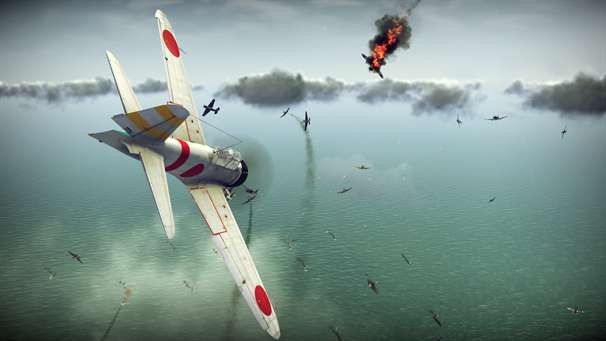
Neeeeeyyyyoooowwmmmmmm, dakka dakka dakka dakka. *Ahem*.
Letting you take flight and dogfight in not only a cavalcade of American and Japanese warbirds, but also planes from Germany, Italy, Russia, and the good old UK, there's a decent selection of planes to keep you busy with here, with the normal flight sim selection complimented by some more unusual ones - from Hurricanes and Spitfires, to tank busting Sturmoviks, to heavy bombers, like the He-111 and Lancaster, and even flying boats, like the Catalina. And brilliantly, there's even a specific single player mission that challenges you to land the latter on the sea. That should tell you all you need to know about just how hard it is.
The main single player game here's split into three sections - Campaign, Single Missions, and the "Dynamic Campaign" - which we'll come back to in a minute. Offering a pretty similar blend of missions, the Campaign and the Single Missions are where you'll head first if you want to delve into some action. With two campaigns on offer, letting you see the war from both the American, and the Japanese perspective, as you may imagine, there's a strong naval bent to the proceedings here, with aircraft carriers to take off from (and sink), tiny Pacific islands to defend, and shipping convoys to torpedo. Just like the old days! With a wide variety of missions on offer, from recon patrols, to bomber intercepts, or torpedo runs on convoys, there's plenty of variation from one mission to the next, with the campaign interspersed with documentary style footage that takes you through the history of what actually happened - which is a nice touch.
Offering something a little different to the campaigns, the single player missions are set across the entire world during World War 2, letting you play as the Russians, British, and Germans, but without the back story, or historical aspect tying everything together. Rather than simple go here, attack these objectives, the single player missions are even more varied than the campaign - whether you're being asked to fly down a narrow valley to fend off the twenty strong squadron behind you, or land a plane on a breakwater, these are challenges for the more experienced pilots to take up - meaning you'll want to play your way through the campaigns first.
Unlike other flight sims, which shy away from anything that could be classed as authentic, Birds of Steel reads like a checklist of what we'd want from a flight sim - you can fly in the cockpit of (most) planes, taking off and landing are important (although optional if you'd prefer) parts of the mission, and there are even little people running around on the deck of the aircraft carrier for you to dodge on take off (don't worry - you can't crash into them).

The calm before the storm. Make sure you let your team mates take off first, mind you.
As flight sims can be somewhat intimidating to the novice pilot, Birds of Steel's attempted to make things a little bit easier for newcomers, with a highly adjustable difficulty level, and a series of training missions designed to ease beginners in. Unfortunately, though, the training missions aren't really much good, as along with having an English person who calls an aeroplane an "airplane" (shudder), they don't really do a very good job of, you know, actually explaining what you're doing. If you have no idea what an aileron, a rudder, and a yoke are before you started, you'll likely end up with something of a headache towards the end, and only a slightly better idea of how to keep your plane in the sky.
The difficulty levels, on the other hand, are much more welcoming - although they don't quite go far enough. Letting you tone down the whole flying thing so that you basically have to only worry about moving the stick in the right direction, when playing in Simplified mode, practically a single shot will take down an enemy plane - although unfortunately, the same's also true for you. While you'd expect that Simplified would make your plane into a practically invulnerable armoured fortress, sadly, it's still far too easy to get shot down. At the other end of the scale (and where we usually reside, because we're masochists like that) there's Simulator mode, which, like it says on the tin, turns the realism up to the max. Stalls, spins, black outs, and red outs are all common here, and while, like on Simplified, a single shot in the right place is enough to take out your plane, enemy attacks do a lot more here - a well placed bullet's all it takes to disable your aileron, jam your rudder, or damage your engine, to make the job of keeping your plane in the air even harder than it already is. You even have to trim your engine. You don't get much hardcore than that.
No matter what difficulty you play on, though, it's easy to see that a lot of effort's gone into making you feel like you're really strapped into a metal bucket of bolts in the sky. Slink in behind a bomber, and hit it's engine, and along with flames, it'll start gushing black smoke and oil - which'll plaster your windscreen, making it impossible to see through. Flying by prayer, and simply hoping you'll miss the hulking great burning thing in front of you as it's falling out of the sky is a real breath-holding moment. Similarly, there's something hauntingly exciting about bombing a ship in the middle of a convoy, with flak exploding all around you, and, if you're unlucky, tearing your wing from your plane. BanzaI!
But while there's undoubtedly an emphasis on realism, there are a few strange things that the game seems to get entirely wrong. You see, if you're making a game set in the pacific, there are a few, crucially important elements that you need to get right - elements that wouldn't necessarily have made the game that much harder for anyone playing on the easier difficulties, either - and yet Birds of Steel, the realistic flight sim, manages to be completely historically wrong. While they've gone as far as to model the people running around on the deck of the aircraft carrier, the much more basic aspect of actually landing on the carrier's been completely messed up. On a World War 2 carrier, managing to successfully land your plane is something of an art, as you're attempting to land something rather large, moving rather fast, on a rather short strip of runway, that's usually bobbing up and down, and from side to side as the ship floats on the sea. It should be a heck of a challenge - and it undoubtedly is - but it's not right. In order to land on a carrier, you need to go from flying, to stopped, in a matter of seconds. In real life, this is done through an arrester hook on the back of your plane, which comes down before you land, with the intent of snagging on one of a number of thick, steel wires, which run across the deck of the carrier - therefore taking your speed to zero in a split second. In Birds of Steel, however, carrier landing's been much simplified - all you have to do is touch down on deck, and your plane will miraculously stop. And while that's certainly OK for the easier difficulty levels, it does spoil the authenticity the game's aiming for somewhat - what would have stopped the game explaining the principal, but letting players on arcade miss the wires entirely and still successfully land? Worse, though, is how the game instructs you to drop torpedoes. "The most important part of dropping a torpedo is speed" the game says, as we nod, knowing what's coming next. "You're a vulnerable target. The faster you are, the harder it is to hit you" ...What?
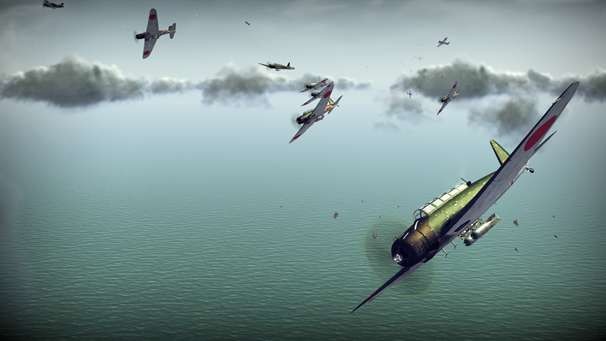
Ah, you know what? Just drop it now. It'll be fine.
The problem is, that's just not right. When dropping a torpedo, you need to be low and slow. That's part of what makes it so tricky. A torpedo's effectively a bomb with a propeller strapped to the end of it - if it hits the surface of the water with too much force, it's going to explode, taking you with it. That's why it's important to go slowly - yet Birds of Steel, which claims to pride itself on accuracy, seemingly thinks otherwise. And again, while you'd expect a fair amount of leeway on easy (you really shouldn't have to slow down at all if you don't want to on Arcade), we'd at least expect it to tell the truth about what you're meant to be doing.
Then we come to the Dynamic Campaign, the final remaining single player mode. In the press releases, this sounds like one of the most exciting parts of the whole package. A relic, reborn from the flight sims of old, the dynamic campaign has always been a simple, yet effective way of making your game effectively last forever. Letting you choose the year your campaign starts, and the area it starts in, the Dynamic Campaign is usually a series of randomly generated missions, which are all tied in to an overarching "campaign". The better you do in the missions, the more damage you'll deal to your enemy, and so the easier later missions will get - at least, that was the theory. Successfully manage to destroy a key runway, aircraft carrier, or factory, and you'll find yourself coming up against less planes in later missions. "Great" we thought, "this'll keep us going forever!" Except, well, it doesn't quite work like that in Birds of Steel.
Instead of being a series of randomly generated missions, the dynamic campaign here lets you choose the missions yourself. After picking the year you want to start from, and where you want to start, you're asked to choose a win condition - along the lines of "take all territories, 3 wins, 5 wins", etc. Complete a mission successfully, and your troops will push into enemy territory, leading you to "take" a sector - although, luckily, there's no micro management of forces to worry about here. Start up the campaign, and you'll be presented with a list of various mission types - from combat patrol, where you just fly around a series of checkpoints, to attack missions on enemy ships, and airfields. And again, there's nothing wrong with this - it's just a slightly different way of doing things. What is a problem is that, sadly, this has been rather badly done.
The first problem is that rather than missions, what you're asked to do here are, for all intents and purposes, suicide trips, such is their difficulty. Choose bomber intercept, for example, and you'll find yourself in a squadron of four planes up against a flight of 40 bombers, with full fighter escort. You're then expected to either shoot down a certain number of these within a certain length of time, or defend a target from being blown up - or else you'll fail the mission. And good luck to you. Although the mode supports online co-op for up to four players, if you're playing in single player, you'll be stuck with AI co-pilots making up the rest of your squadron, who spend all their time dog fighting with the fighters when the entire mission's success revolves around taking out the bombers. Should you actually manage to win, it'll be an achievement in itself.

Sometimes, it can feel like the odds are against you.
With a single bullet being all it takes to turn your plane into a lump of scrap metal, you'll find yourself getting shot down a lot - but in Birds of Steel, the mission isn't over as soon as you get killed, as you can choose to jump ship, and take over one of your wingmen's planes. It's an OK idea in theory, but when your wingmen get shot down well before you do (as often happens, thickies as they are), you've got no-one left to take over, as they've effectively just wasted three of your four lives for you. Even more frustratingly, this is also true for the single player and campaign missions - you have, at most, four attempts to get through each mission - should any of your wingmen get shot down before you do, you effectively lose a life without even raising a finger. Some missions even inexplicably only give you a single life in which to complete them. More maddening still, in a complete reversal of logic, when you're playing the Dynamic Campaign online, you effectively get unlimited lives, as, so long as one of your squadron's still flying, you can respawn! So not only are you up against hundreds of planes on your own, not only do you have AI wingmen with the intelligence of bricks, but you also have a limited number of lives -unless you play online! Was this mode actually ever tested in single player? Sadly, few missions ever give you realistic goals to accomplish - and we think we can see the reason why.
You see, the game has a huge emphasis on online play. Too much of one, in fact. When you start playing the game, you'll notice a menu in the top right of the screen which has a number of icons beneath - lion points, for want of a better word, medals, and a picture of a plane, each with a number next to them. Press Y, and you'll be able to view your profile, where, after a bit of deduction, as nothing's explained, you'll figure out that the number next to the aeroplane is how many aircraft you've unlocked to fly in, and the lion points are what you use to buy them with. How you earn lion points is initially unclear - as we mentioned, there's nothing there to explain it. It turns out, these are rewards for playing multiplayer modes. Play online against real people, and every time you shoot someone down, take off, or complete the mission, amongst other accomplishments, you'll be rewarded with these lion points, along with XP. Earn enough XP, and you'll level up, unlocking extra planes, which you can then buy with the lion points you've earnt. The planes you unlock can then be flown in the Mission Builder, where you can create missions in an incredibly simplified manner from a number of variables, and the Dynamic Campaign, where, incredibly, when you start off, you actually won't be able to fly at least three types of missions, because you haven't unlocked the planes you need.
In single missions, and the campaign, you'll earn XP for taking off, shooting down enemies, and completing the mission, but no lion points. The only way to earn lion points is in the multiplayer modes, and the dynamic campaign - which has seemingly been designed to be played by a minimum of four human players, such are the odds you're against. That, at least, explains why you can earn lion points for doing it - but it's also the only way to earn these lion points without a connection to Xbox Live. That means if you've bought the game, and you want to be able to fly in the planes that you've paid for, you'll have to attempt the Dynamic Campaign in single player - which we've already explained the problems with. Why these points have been restricted to the worst mode in the game is anyone's guess - but it's a frustration that's bound to hold most people back from truly enjoying themselves. It'd almost be OK if you were only unlocking the planes for use in the multiplayer modes - but you're not. That it's so much easier to earn these points in the multiplayer mode makes the game a lot harder - and a lot less enjoyable for those who either don't have a subscription to Xbox Live, or simply don't enjoy playing online - which we'd imagine would make up a large portion of the market for this game.
Then there are the other weird things that invade every mode in the game. After you've fired a certain number of shots from your plane, you'll be unable to fire for 30 seconds. While we initially thought this was intended to simulate either your guns jamming, or overheating, we can only assume that it's actually simply that you've run out of ammo, and are waiting for your guns to reload. Which is more than a bit annoying when you've chosen to fly with unlimited ammo, and it happens just as you've managed to line your target up in your sights. In Versus mode, although the game adds AI controlled opponents in to make up the numbers, it's impossible to play without two human players. Quite why this is is beyond our comprehension, as it would have added some variety to the modes a single player could partake in - and given you another way to earn lion points. Compounding our problems with the Dynamic Campaign mode is the fact that it's actually impossible to save mid-campaign. That means you've got to try and finish the whole campaign in a single sitting. Should you end up trading wins with the computer, that could take hours. Would it have been that much to ask for a save game?

Sometimes, it feels like Birds of Steel's lost its wings.
The game suffers from numerous glitches too. Twice during our time with the American campaign, the game actually crashed us into the ground, during a cutscene. As it was a cutscene, we had no control over our plane, so the game cost us one of our lives - luckily, we had a few wingmen left, or it would have caused us to fail the mission. In a later mission, we were flying over an Aircraft Carrier we were meant to be attacking, when the game informed us we'd completed the mission, and sunk the carrier. We'd barely even looked at it. We were then attacked by Japanese Zeros, so, switching to the gunner turret to defend ourselves (disappointingly, you don't actually get to go in the turret - you just switch to a third person view and aim them), we took a few pot shots at the fighters - while the AI pilot of our plane decided to fly vertically upwards. After wrestling the controls back and levelling the plane, we switched back to the gunner controls again, where the same thing happened, only this time, downwards. Seemingly, the computer doesn't fly for you when you man the turrets. Similarly, during one of our adventures online, upon attempting a co-op mission, when we were flying a German Stuka, the game assured us that the British Spitfires chasing after us, and trying to shoot us down were our friends. Seemingly, it had got our allegiances entirely wrong, marking our enemies as friends, and our friends as enemies.
And you know what's the most frustrating about all this? It's that without the Dynamic Campaign faff, Birds of Steel would have been so much better. In fact, had the Dynamic Campaign given you missions that were a bit more achievable if you're playing on your own, and if the game let you earn lion points in single player missions, those two changes alone would have hugely changed the game. There's so much potential here, and so much done right - or nearly right. Each of the planes has been incredibly recreated, and just being able to fly around the pacific, torpedoing ships again, like in the good old days is enough to give us goosebumps. We usually love games like this. But why is everything so multiplayer oriented? And why do we have to either play online, or slog through the worst mode in the game to unlock the planes I've earnt? What's even more frustrating is that the game's predecessor, IL-2 Sturmovik, had none of these problems. You unlocked planes as you earnt them by playing the campaign, the Dynamic Campaign didn't exist, there wasn't so much of an emphasis on multiplayer, and the game as a whole was more stable, less buggy, more enjoyable, and more scalable for both novices and experts alike. Little things have been removed, like the picture in picture target box, which showed if you were hitting your enemy when you were firing from a distance, and as such was an incredible help when you were just getting the hang of the game. Sturmovik gave you unlimited attempts at a mission too. Pretty much every problem that's been introduced is something that's been added as a new "feature" for this game. Were it just Sturmovik in the Pacific, with a proper Dynamic Campaign that actually functioned, we'd be looking at a 9 or 10 here. Instead, what we're left with is a game that's frustrating for the hardcore flight sim enthusiasts and novices alike - while it undoubtedly has potential, for the average player, or the non-online player, it's going to be hard to get into this one.
Format Reviewed: Xbox 360


